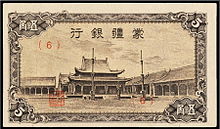Bailingmiao
Bailingmiao ( Chinese 百靈廟 , Pinyin Bǎilíngmiào , W.-G. Pai-ling-miao , Mongolian Bat Chaalga or Mongolian Bathahalak ) is a small place around the temple of the same name in the modern united Darhan-Muminggan banner not far from the city of Bāotóu (包頭 市, W.-G .: Pao-t'ou ). Administratively, the place at the northern foot of the Yin Shan Mountains is now a large municipality.
history
The eponymous temple was built in 1781 on the basis of an older one built in 1702 for which the Kangxi emperor had deigned to donate a name plaque with the inscription Guǎngfú sì ( 廣 福寺 ). In its heyday it consisted of five main halls with nine Chinese-style pagodas, plus 36 buildings of Tibetan design, the latter used by lamas of the Gelugpa sect.
Artillery fire from Chinese troops set fire to the Tibetan part of the temple during fighting with Mongolian independence fighters on July 10, 1913. Sven Hedin mentioned in 1927 that the temple was rebuilt ten years later, partly with government money.
1934-1936
The village became internationally known when the "Prince" Demchugdongrub (alias Teh Wang) , who came from the western Sünit banner , set up the administrative headquarters of his "autonomous Mongolian council" ( 蒙古 地方自治 政務 委員會 ) here. The creation of this “autonomous government” headed by the prince striving for independence for Inner Mongolia was an attempt by the Nanking KMT regime, established in 1927, to secure its nominal claims to rule in an area in which one never really had control. Shortly before, the province of Rehe had come under Japanese administration.
In November 1934 a radio station was built. The members of the government, who meet twice a year, lived during their stays in yurts, which then formed the village. Because of the temple, women were traditionally not allowed to stay in it, so families were accommodated further down the steppe. Only the prince and his staff used a solidly built yamen as the official residence, as long as he did not prefer to hold court in a yurt. Some Chinese traders who soon immigrated built permanent houses. A new “capital of all Mongols” about ten kilometers away never got beyond the planning stage. A meeting of the Japanese officer Ryūkichi Tanaka ( 田中 隆吉 ) with the prince led to a rapprochement with the Japanese without growing into a full alliance. It wasn't until August that the ties became closer.
In the spring of 1936 the Bailingmiao uprising broke out . As part of the Suiyuan campaign from summer 1936, the village, defended by 4,000 men, was captured by Chinese troops in the seventh attack on Nov. 25, 1936. Mongols advancing on Bāotóu recaptured the place in early October 1937. Further fighting with the Japanese took place in late 1938.
Like the surrounding region, Bailingmiao belonged to the Mongolian military government of the Demchugdongrub in 1938/39, then to Mengjiang until August 1945 .
Since 1945
In the summer of 1950 there was still fighting in the region, with rebels, remaining supporters of Demchugdongrub, taking action against the liberators .
The abbot of the monastery attended the founding meeting of the Chinese Buddhist Association in 1953. In 1958 the first elementary school opened. The temples were destroyed during the Cultural Revolution.
About 700 people currently live in the village. The provincial road 211 from Bāotóu continues into the independent Mongolia, the provincial capital Hohhot ( 呼和浩特 , Hūhéhàotè ) can be reached on the S104.
The site of the Bailingmiao Uprising has been on the List of Monuments of the People's Republic of China (No. 6-912) since 2006 .
literature
Contemporary western descriptions exist outside of daily newspapers only from the Swedish missionaries resident in the region. First and foremost, these were Pastor Söderbom, Joel Erikkson and Frans August Larson (Г. Ганболд).
- Larson, Frans; Larson, Duke of Mongolia; Boston 1930; eBook: Read Books Ltd. 2013, ISBN 978-1-4474-8541-4 ; German (exp.): Mongolia and my life with the Mongols; Berlin 1936 (Kiepenheuer)
- Larson, Frans; The mongoliska tragedies: glimtar ur mongolernas historia; Uppsala 1950 (Lindblad)
- In the journal Pacific Affairs, 1936, No. 1, p. 1930 there is a compilation of book titles in which the region is mentioned.
- Japanese reports on excavations:
Individual evidence
- ↑ 忒 莫勒; 民国初年 百灵庙 被焚 考; 内蒙古 师范大学 学报, 1998, pp. 80-3.
- ↑ English officially; Mongol Local Autonomy Political Affairs Committee.
- ↑ Hong Kong Daily Press, 1934-11-07, p. 8.
- ↑ Bosshardt, Walter ; Cool Prairie Mongolia; Zurich 1949 [orig. Berlin 1937], chap. "The capital without women."
- ↑ Hong Kong Daily Press, 1936-11-25, p. 1.
- ↑ China Mail, 1937-10-05, p. 1.
- ↑ Hongkong Daily Press, 1950-08-15, p. 3.
- ^ West Australian (Perth), 1953-06-23. For the organization cf. Lohner, Henry; Buddhist temples in China; Norderstedt 2017, Vol. 2, p. 642. ISBN 978-3-7448-7273-7 .
Web links
- Pictures of the temple 2011, ch.
Coordinates: 41 ° 42 ' N , 110 ° 26' E


